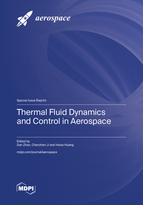Thermal Fluid Dynamics and Control in Aerospace
A special issue of Aerospace (ISSN 2226-4310). This special issue belongs to the section "Aeronautics".
Deadline for manuscript submissions: closed (31 December 2022) | Viewed by 23624
Special Issue Editors
Interests: thermoacoustics; combustion instability; aeroacoustics noise; aeroelasticity
Special Issues, Collections and Topics in MDPI journals
Interests: combustion instability and combustion noise control; aeroacoustics; clean combustion; computational fluid dynamics
Special Issues, Collections and Topics in MDPI journals
Interests: aerodynamics in high-speed inlet; internal flow; shock/boundary layer interaction; flow control
Special Issues, Collections and Topics in MDPI journals
Special Issue Information
Dear Colleagues,
This Special Issue is cooperating with the 3rd International Conference of Thermal Fluid Dynamics and Control (ICTFDC 2022, http://www.ictfdc.com/), which will be held in the form of online meetings on 20–22 August 2022.
The conference is a premier event in the Aerospace/Thermal-fluids Science and Technology communities. It brings together professors, engineers, and experts from academic universities, research centers, and the gas turbine and engine industries. The conference offers excellent networking, collaboration, and sharing opportunities with attendees from many research fields, disciplines, and countries.
The topics of interest include CFD, theoretical, and/or experimental studies on:
- Aerodynamics;
- Aeroacoustics;
- Structure and vibration;
- Propulsion and combustion;
- Active and passive control;
- Thermal fluids;
- Thermoacoustic engine/cooler;
- Energy harvesting and conversion;
- Heat and mass transfer;
- Thermodynamics;
- Combustion instability and control;
- Fluid mechanics and dynamics.
Authors of outstanding papers related to these topics and aerospace are invited to submit extended versions of their conference work to this Special Issue for publication. Non-conference submissions are also welcome and will be considered for publication.
We look forward to welcoming you and to making ICTFDC 2022 a successful event, and we welcome you to submit your outstanding research works to this Special Issue.
Prof. Dr. Dan Zhao
Dr. Chenzhen Ji
Dr. Hexia Huang
Guest Editors
Manuscript Submission Information
Manuscripts should be submitted online at www.mdpi.com by registering and logging in to this website. Once you are registered, click here to go to the submission form. Manuscripts can be submitted until the deadline. All submissions that pass pre-check are peer-reviewed. Accepted papers will be published continuously in the journal (as soon as accepted) and will be listed together on the special issue website. Research articles, review articles as well as short communications are invited. For planned papers, a title and short abstract (about 100 words) can be sent to the Editorial Office for announcement on this website.
Submitted manuscripts should not have been published previously, nor be under consideration for publication elsewhere (except conference proceedings papers). All manuscripts are thoroughly refereed through a single-blind peer-review process. A guide for authors and other relevant information for submission of manuscripts is available on the Instructions for Authors page. Aerospace is an international peer-reviewed open access monthly journal published by MDPI.
Please visit the Instructions for Authors page before submitting a manuscript. The Article Processing Charge (APC) for publication in this open access journal is 2400 CHF (Swiss Francs). Submitted papers should be well formatted and use good English. Authors may use MDPI's English editing service prior to publication or during author revisions.








